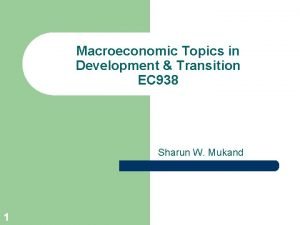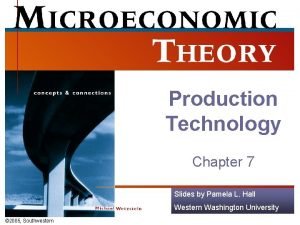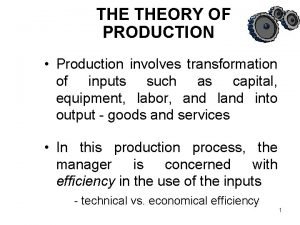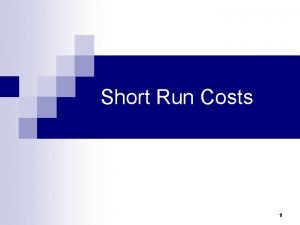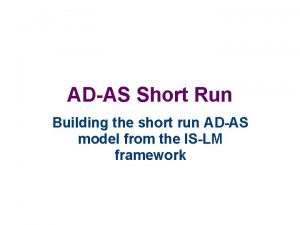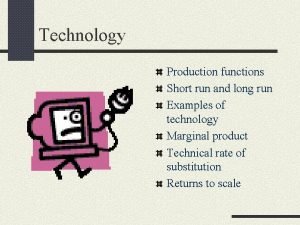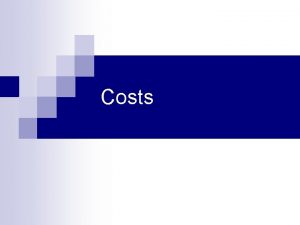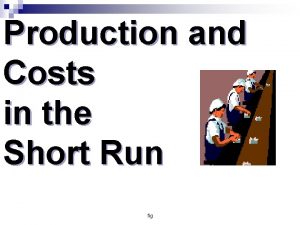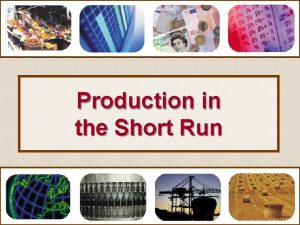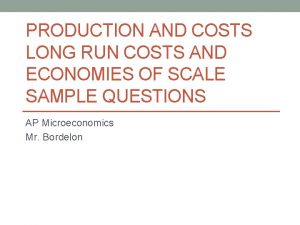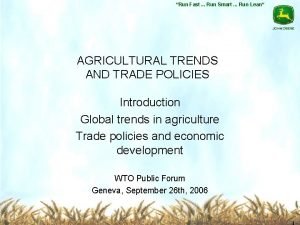PRODUCTION COSTS Definitions Short run costs costs that













- Slides: 13

PRODUCTION COSTS

Definitions Short run costs: costs that can change when certain resources are fixed Long run costs: costs that can change when all resources are variable Total variable costs: costs that are incurred when variable resources are hired � Ex: wages and materials costs Total fixed costs: costs that are incurred when hiring resources that can not be changed in the short run � Ex: factory (rent, mortgage) and equipment costs

Examples of Differences in Short v Long Run with different producers Diana (Fruit grower) Immediate time: Right now If demand for fruit increases, Diana wants to produce more fruit Diana can NOT alter production of fruit in the immediate time frame Short run options: Diana can work her employees longer hours to pick fruit Long run options: Diana can invest in new machinery to pick fruit, buy more land plant new fruit to grow (this could take years to see growth)

Maria (fruit smoothie producer) Immediate time frame: right now Consumer demand for fruit smoothies has increased. Maria would like to sell more smoothies. Short run options: Maria can buy more supplies (fruit, cups, sauces etc. ) and work her employees longer Long run options: expand her store, buy more machinery, hire more workers (this could take months to finish)

So, why did the demand for fruit and fruit smoothies increase? Are they tied together? Reason: new health reports say that eating more fruit smoothies leads to greater health benefits. Therefor the demand for fruit smoothies has increased. Fruit smoothie producers now need more fruit for their smoothies. So, they contact fruit growers and demand more fruit leading to a need to expand fruit production.

Definitions con’t Marginal Cost: the additional cost incurred each time a resource is hired Average total cost: the total cost divided by the output Average variable cost: total variable cost divided by the output Average fixed cost: total fixed cost divided by the output

Total Costs Total costs – the sum of all costs of producing � Includes fixed and variable costs Total fixed costs will never change regardless of how much is produced Total variable costs will increase as more inputs are hired Total cost will always follow what total variable costs do

Graphing Total Costs

Total variable will rise quickly at first, level off and then begin to rise quickly again � Rise 0 because initial cost of all resources is met production to initial production levels � Levels off because not many resources are needed to see increase in production Specialization in workers occurs, not as many people needed to see big increases in production

� Increases again as overcrowding takes place and production slows down Too many variable resources and not enough fixed resources (have to share). Have to hire more and more resources to get same increases in production as before Example: Balloon Tower production

Total costs will always rise � Not enough information to decided optimal amount of resources to hire Marginal costs � Additional costs from production � Only reflect change in variable costs � Will rise sharply (initial production), fall (specialization) and then begin to rise rapidly (overcrowding)

Average costs: � Reflection of cost per unit of producing � AFC will always fall � ATC will fall at first then begin to rise � AVC will fall at first then begin to rise � If MC < ATC then ATC will fall No matter if MC is falling or rising MC > ATC then ATC will rise MC will be rising � MC crosses ATC at the lowest point for ATC

Graphing MC and ATC
 Tall + short h
Tall + short h Long run equilibrium under perfect competition
Long run equilibrium under perfect competition Short run vs long run economics
Short run vs long run economics Long run market supply curve
Long run market supply curve Apa itu pre-production?
Apa itu pre-production? Three stages of short run production function
Three stages of short run production function Involves transformation of
Involves transformation of Phân độ lown
Phân độ lown Block xoang nhĩ
Block xoang nhĩ Thể thơ truyền thống
Thể thơ truyền thống Thơ thất ngôn tứ tuyệt đường luật
Thơ thất ngôn tứ tuyệt đường luật Walmart thất bại ở nhật
Walmart thất bại ở nhật Tìm vết của đường thẳng
Tìm vết của đường thẳng Con hãy đưa tay khi thấy người vấp ngã
Con hãy đưa tay khi thấy người vấp ngã


